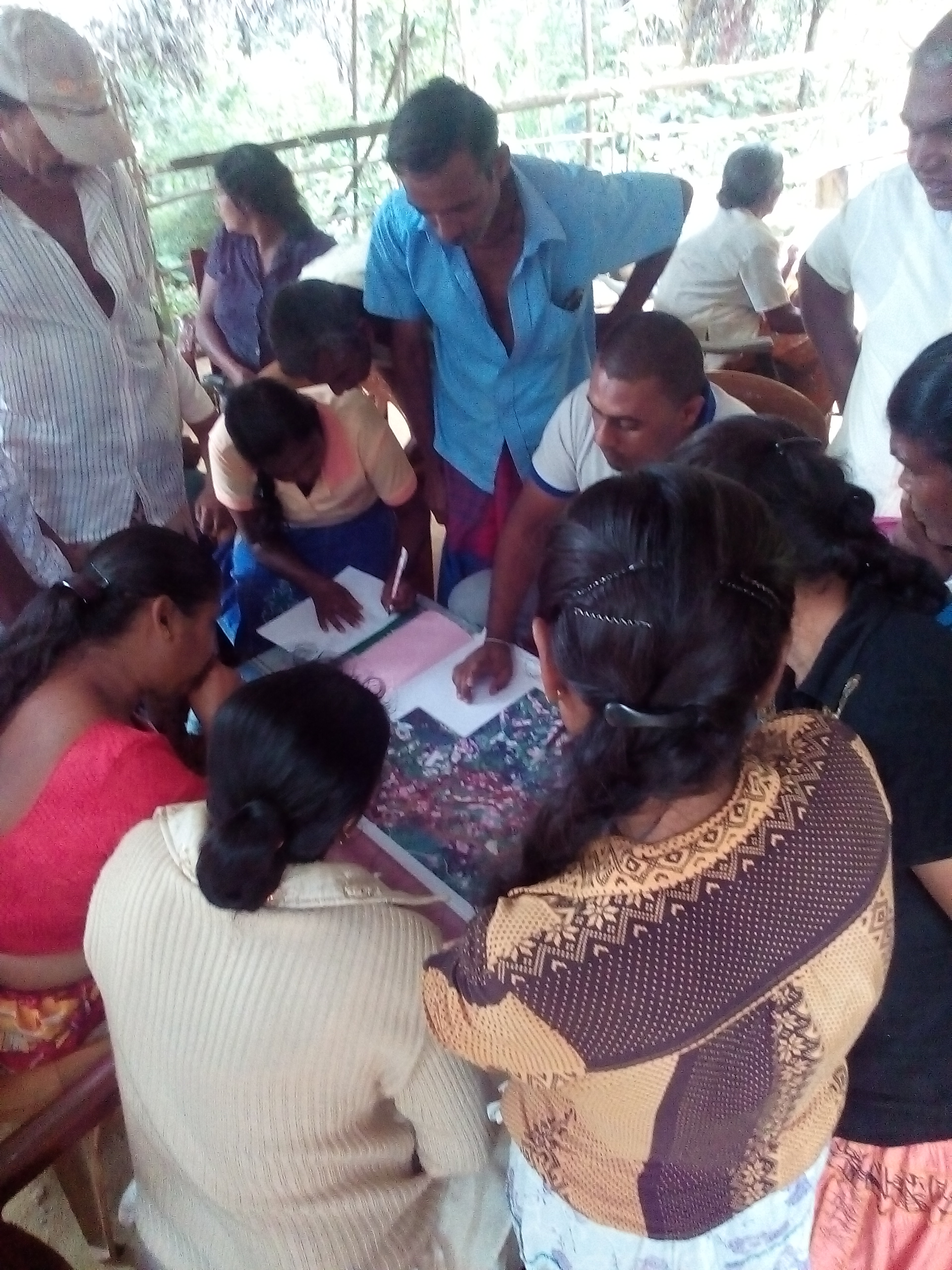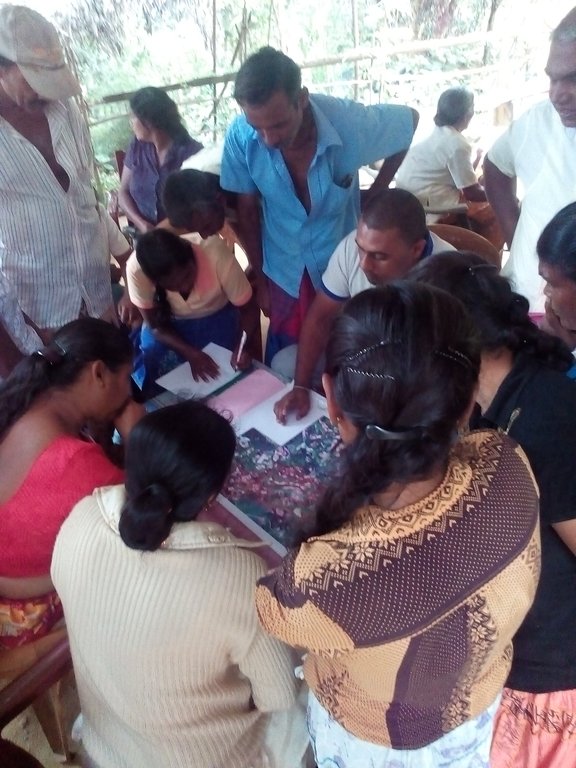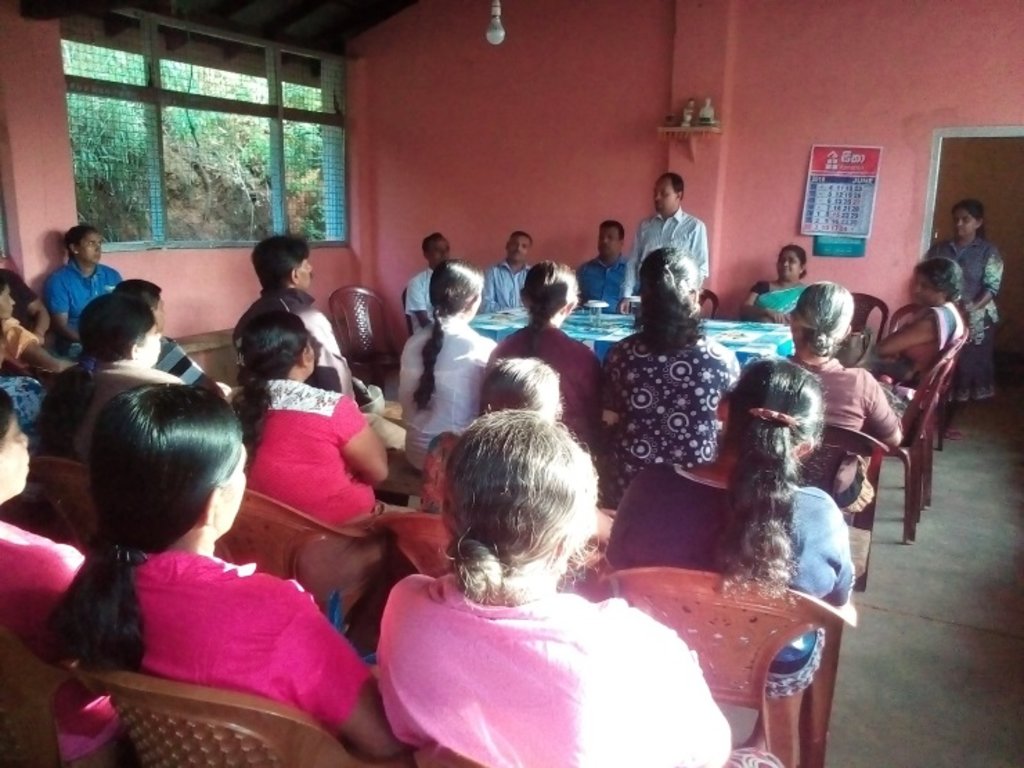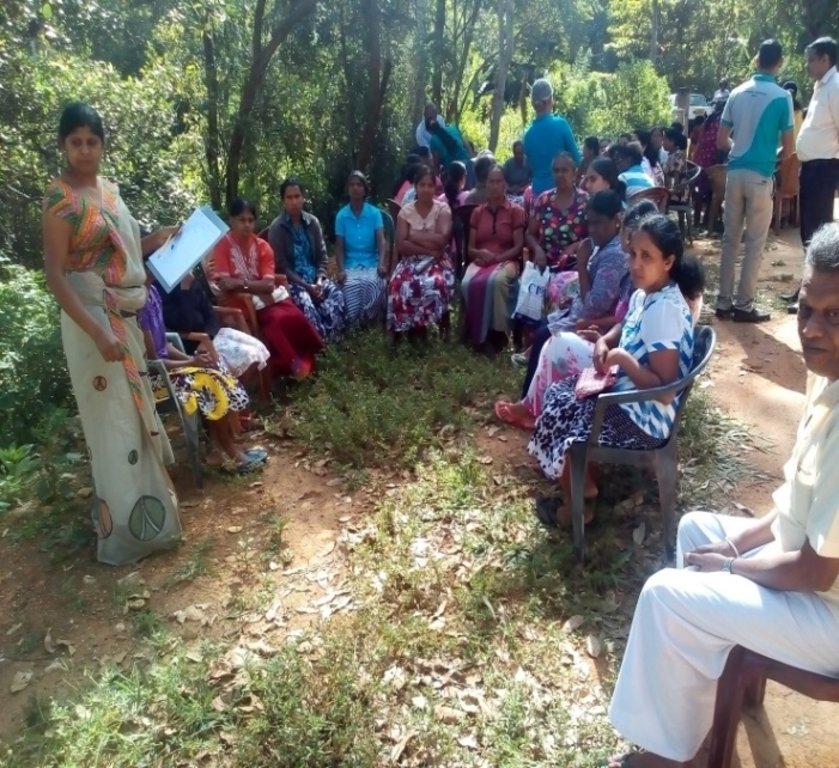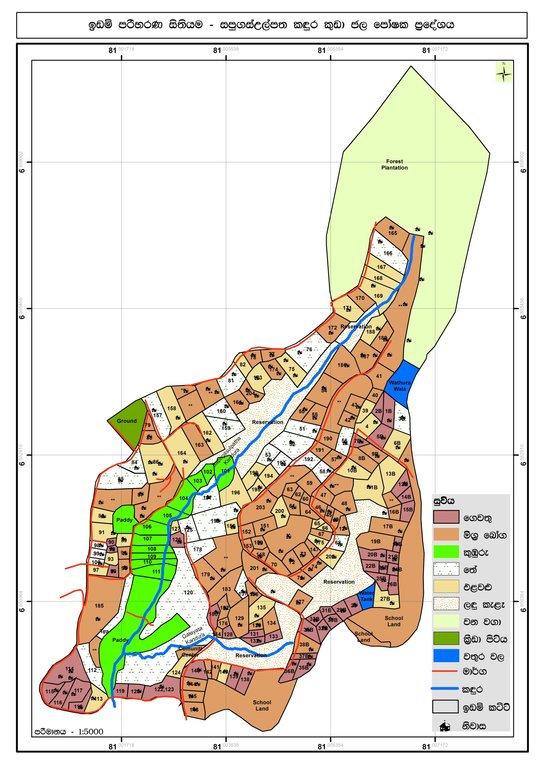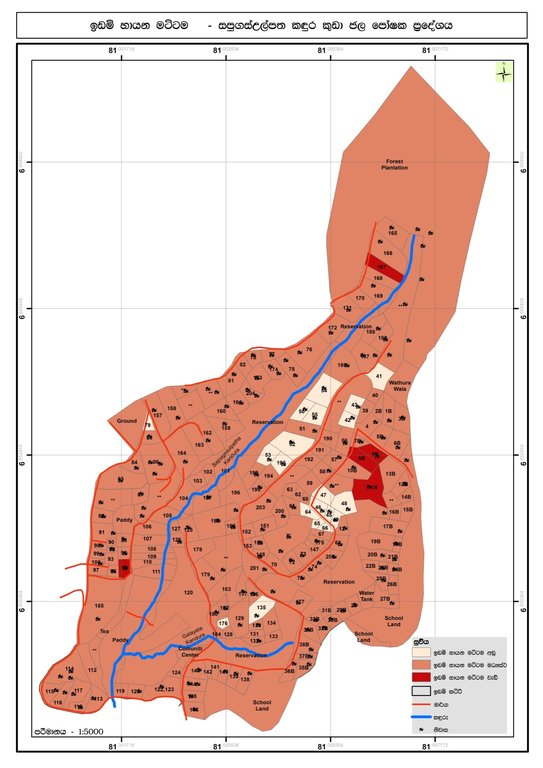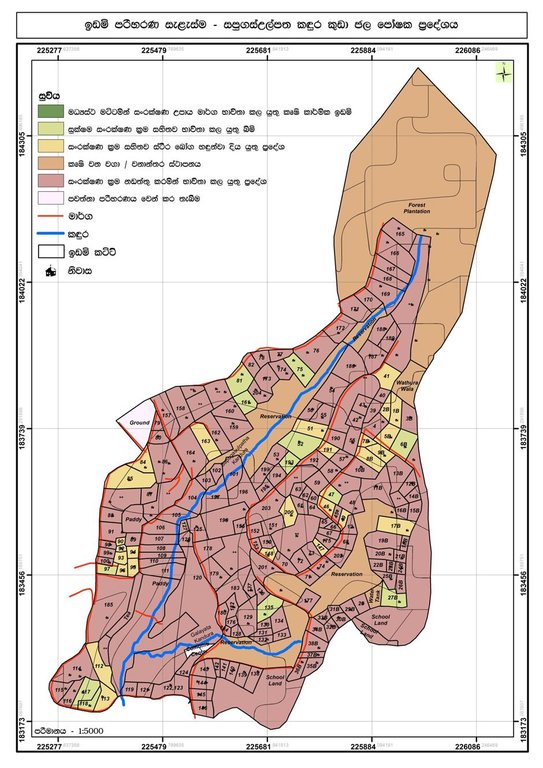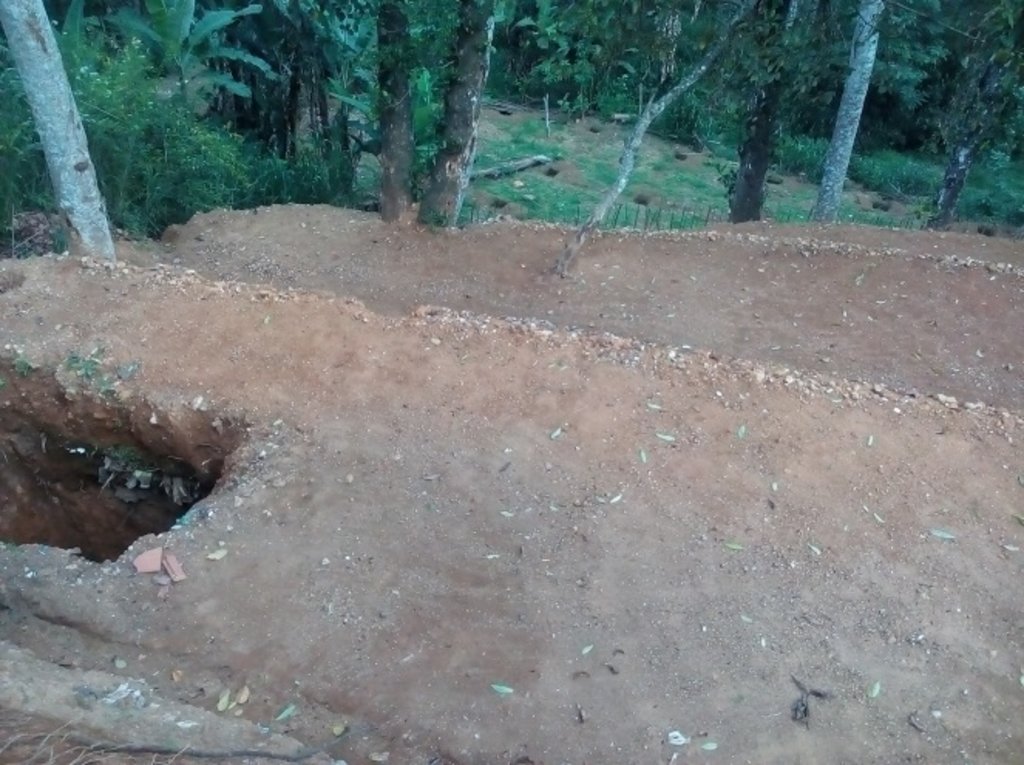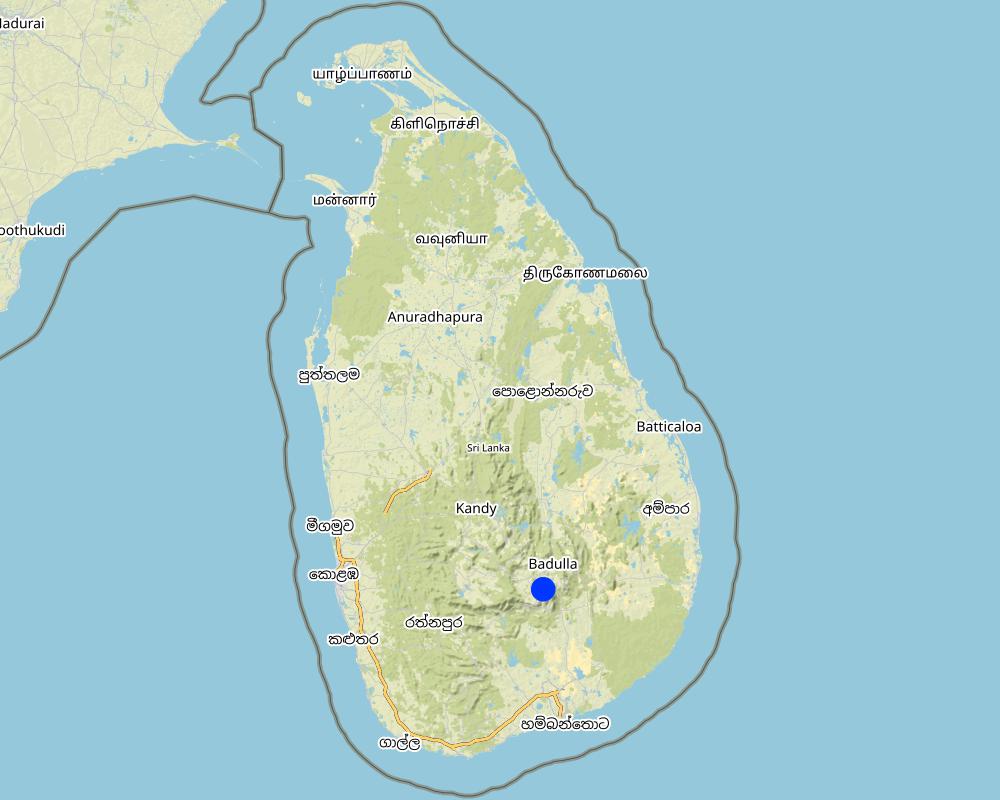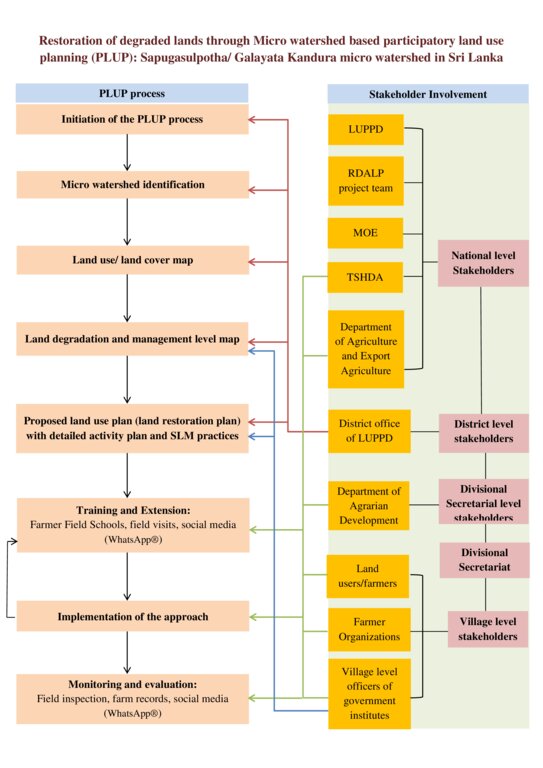Restoration of degraded lands through participatory land use planning [Шри ланка]
- Шинийг нээх:
- Шинэчлэх:
- Эмхэтгэгч: Head Soil Science
- Хянан тохиолдуулагч: –
- Хянагчид: William Critchley, Rima Mekdaschi Studer
Village-based participatory land use planning
approaches_6237 - Шри ланка
Бүлгүүдийг үзэх
Бүгдийг дэлгэх Бүгдийг хаах1. Ерөнхий мэдээлэл
1.2 Арга барилыг баримтжуулах болон үнэлгээ хийхэд оролцсон хүн эсвэл байгууллагын холбоо барих хаяг
хамтран эмхэтгэгч:
хамтран эмхэтгэгч:
Agrarian Research and Production Assistant:
Karunarachchi Mangalika
+94714955038
Department of Agrarian Development
Agrarian Research and Production Assistant Office, Galayata Kandura, Bindunuwewa, Bandarawela.
Шри ланка
Газар ашиглагч:
Podimenike W.M.
+94572232842
Galayata Kandura, Bindunuwewa, Bandarawela.
Шри ланка
Арга барилыг баримтжуулах/үнэлэх ажилд дэмжлэг үзүүлсэн төслийн нэр (шаардлагатай бол)
Rehabilitation of Degraded Agricultural Lands in Kandy, Badulla and Nuwara Eliya Districts in the Central Highlands of Sri LankaАрга барилыг баримтжуулах/үнэлэх ажилд дэмжлэг үзүүлсэн байгууллага(ууд)-ын нэр (шаардлагатай бол)
Faculty of Agriculture, University of Peradeniya, Sri Lanka (AGRI.PDN) - Шри ланка1.3 WOCAT-аар баримтжуулсан өгөгдлийг ашиглахтай холбоотой нөхцөл
Мэдээллийг хэзээ (газар дээр нь) цуглуулсан бэ?
24/02/2022
Эмхэтгэгч болон гол мэдээлэгч хүн(хүмүүс) WOCAT аргачлалаар баримтжуулсан мэдээллийг ашиглахтай холбоотой нөхцлийг хүлээн зөвшөөрсөн:
Тийм
2. ГТМ Арга барилын тодорхойлолт
2.1 Арга барилын товч тодорхойлолт
Microwatershed-based participatory land use planning is a systematic and interactive process that primarily focuses on the optimal allocation of village land resources according to needs and demands of the people while promoting sustainable land management. Key features of this approach are multi-sectoral coordination, multi-stakeholder engagement and the active participation of land users throughout the participatory land use planning process.
2.2 Арга барилын дэлгэрэнгүй тодорхойлолт
Арга барилын дэлгэрэнгүй тодорхойлолт:
The Sapugasulpatha/ Galayata Kandura microwatershed is located in Bandarawela Divisional Secretariat (DS), Badulla District, Sri Lanka. Unsustainable land management has led to land degradation causing associated challenges. There was a need to identify strategies for restoration of degraded lands while addressing water scarcity. In 2018, the Rehabilitation of Degraded Agricultural Lands Project (RDALP) introduced participatory land use planning (PLUP) for this microwatershed. Previously, stakeholders were dealt with individually. But the PLUP process relies on the active involvement of all stakeholders. Key is microcatchment level planning - embedded in multi-sectoral coordination and multi-stakeholder engagement.
The process is initiated by the district office of the Land Use Policy Planning Department (LUPPD). Firstly, the LUPPD identifies microwatersheds and develops land use/cover maps. It is assisted by the Bandarawela DS, which is the administrative body for lands in the area and has the capacity to coordinate all relevant stakeholders. Then, officers of the LUPPD meet with community leaders, representatives of farmer organizations and field level officers to verify the land use maps through field visits. Demarcation of individual plots on these maps is also carried out. Next, a field visit is conducted with all stakeholders to identify the status of land degradation and the current crop management practices. This is, effectively, “training of trainers”. Subsequently, the community prepares maps of land degradation and management types with the support of LUPPD.
This is followed by a participatory rural appraisal (PRA) process with all stakeholders. In the PRA, issues related to land degradation/use, ownership, conflicts and socio-economic concerns are discussed. Participants come to an initial consensus on solutions. After this, a detailed action plan is prepared and stakeholders identified. The next stage involves the development of land use plans for the entire microwatershed targeting the restoration of degraded and poorly managed lands. The land use plan covers both on-farm and off-farm land, and provides recommendations for SLM practices over the entire microwatershed: it serves as a detailed land restoration plan. Then, detailed discussions are held with specific stakeholders to prepare sector-based plans. This includes detailed plans for individual farms. As an example, officers of Tea Smallholdings Development Authority (TSHDA) provide inputs to develop detailed plans for smallholder tea cultivation - including plans for individual farmers. Subsequently, implementation is performed jointly by stakeholders. If, for example, a farm is identified for tea cultivation intercropped with export crops, officers both from TSHDA and the Department of Export Agriculture extend their support. The approach includes farmer field schools (FFS) conducted by the Department of Agrarian Development officers and project officers of RDALP. Moreover, farmers are encouraged to use social media (WhatsApp®) to share their knowledge and experiences with SLM practices. The local community is also exposed to examples of good SLM through field visits. The final step is evaluation and monitoring. This is performed by the officers of the Agrarian Service Development, RDALP, and also by individuals. A divisional agricultural committee is mandated to perform continuous monitoring of implementation. PLUP provides the stimulus for farmers to continue SLM - since practices are not enforced but identified themselves. Further, firm bonding is established between land users and other stakeholders, including government institutes, strengthening the likelihood of sustainability.
2.3 Арга барилын зурагууд
2.4 Арга барилын бичлэгүүд
Тайлбар, товч тодорхойлолт:
https://youtu.be/uHBRGYVT--M
Participatory Land Use Planning for Sustainable Land Management
Огноо:
03/08/2021
Байршил:
Dambugasagala, Welimada
2.5 Арга барил нэвтрүүлсэн улс орон / бүс нутаг / байршил
Улс:
Шри ланка
Улс/аймаг/сум:
Badulla District - Uva province
Байршлын дэлгэрэнгүй тодорхойлолт:
Watagamuwa Grama Niladhari Division, Bandarawela Divisional Secretariat Division
Map
×2.6 Арга барилыг эхлэх, дуусах огноо
Эхлэх жилийг тэмдэглэ:
2018
Хугацаа дуусах жил (Хэрэв арга барил удаанаар ашиглаагүй бол):
2021
Тайлбар:
Stakeholders continue to provide extension service for this microwatershed, even though the project was finished.
2.7 Арга барилын төрөл
- төсөл / хөтөлбөр дээр үндэслэсэн
2.8 Арга барилын үндсэн зорилго, зорилтууд
1)Identification and mapping of degraded lands at microwatershed level.
2)Integration of multi-sectoral coordination and multi-stakeholder engagement in participatory land use planning implemented at village micro watershed level.
3)Identification of land management related issues and factors contributing to land degradation and prioritizing sustainable land use/management options through participatory approach.
4)Development and implementation of a land use plan and an action plan to restore and mitigate the degradation within the micro watershed employing PLUP approach.
5)Maintenance and promotion of ecosystem services for the sustainability of rural livelihoods.
6)Reduction of the pressure of competitive land use on natural resources.
2.9 Арга барилын хүрээнд хэрэгжсэн Технологи/Технологиудад дэмжсэн эсвэл саад учруулсан нөхцлүүд
нийгэм / соёл / шашны хэм хэмжээ, үнэт зүйлс
- Идэвхижүүлэх
Greater social capital as local community is well organized with a strong social bonding among villagers. Farmer organization with leaders appointed by villagers further strengthened the bonding between people for agriculture/ land management related activities.
- Хазаарлалт
Lack of interest of young generation on farming.
санхүүгийн нөөц, үйлчилгээний хүртээмж / боломж
- Идэвхижүүлэх
Having access to a comprehensive land use plan for each land increases access for financial resources such as loan facilities from banks, subsidy schemes of TSHDA, Loan facilities of tea factories. Farmers have the option to come with an agreement with a leading supermarket chain in Sri Lanka to obtain financial services/materials with the promise of supplying the products exclusively to the said supermarket chain.
- Хазаарлалт
Existing financial wellbeing of farmers and land ownership related issues limits the access.
Бүтэц зохион байгуулалт
- Идэвхижүүлэх
National, regional and village level institutional set up is existing. Moreover, farmer organizations have strengthened the collective power of farmers to coordinate with institutes. Female farmers have formed “Sithamu” Women's Farmers' Organization and both female and male farmers in the village have formed “Galayata Kandura” Rural Farmer Organization. Land use plan serves as a common platform for the collaboration between institutes enhancing the overall synergy.
- Хазаарлалт
Often the lack of coordination between sectoral institutes and top-down approach in decision making. Lack dedicated institutes to coordinate activities at national level.
талуудыг хамтын ажиллагаа/зохицуулалт
- Идэвхижүүлэх
Officers of relevant government institutes namely, DS, LUPPD, Extension service of the Department of Agriculture, Department of Agrarian Development, Department of Export Agriculture and TSHDA are willingly to support farmers. Moreover, RDALP project officers play an important role in coordinating the activity.
Хууль, эрхзүйн хүрээ (газар эзэмшил, газар, ус ашиглах эрх)
- Идэвхижүүлэх
Majority of farmers own their lands (home gardens and tea smallholdings). Legal frameworks of land ownership and land and water usage are well established.
- Хазаарлалт
Delays and complications in solving legal issues pertaining to land use
Бодлогууд
- Идэвхижүүлэх
Land use policy, soil conservation act, national action plan (NAP) to combat land degradation
- Хазаарлалт
Lack of implementation of policies and acts
Газрын засаглал (шийдвэр гаргах, хэрэгжүүлэх, шаардлага)
- Идэвхижүүлэх
Presence of land use committee (at divisional level) and divisional agriculture committee (included all government institutes related to land use) for decision making. The DS is the chairperson of these committee who is also a part of the PLUP process. Farmers have the liberty to take land use decisions within the framework of land use policy and administrative framework. However, field level officers representing government institutes such as LUPPD, Department of Agriculture, Department of Export Agriculture, TSHDA play a supporting role in implementation of these decisions. Absence of Gender biasedness is a very important factor.
- Хазаарлалт
Land ownerships, conflicts on land ownership, illegal encroachment of sensitive areas of the micro watershed and political interferences
ГТМ-ийн талаарх мэдлэг, техникийн дэмжлэг авах боломж
- Идэвхижүүлэх
Farmer organizations serve as a platform to share knowledge on SLM. Strong village level extension service is facilitated by the Department of Agriculture, Export Agriculture, TSHDA and other technical services. These officers are available at Agrarian Service Centre and Wednesdays are allocated for meeting with farmers. Moreover, conducting field visits is a part of their duty. Farmer groups have been identified and introduced social media platforms such as WhatsApp® to share SLM knowledge by experts and among themselves. Farmers are capable of operating online interaction facilities such as Zoom® allowing experts to share the knowledge conveniently.
- Хазаарлалт
Inadequacy of extension officers
зах зээл (материал худалдан авах, бүтээгдэхүүн борлуулах), үнэ
- Идэвхижүүлэх
Farmers have the choice of marketing their products and enter into the value chain i.e. direct selling at the village vegetable market, private companies those visit to the field for purchasing their products (vegetable, spice crops and tea) and intermediate buyers. Farmers also have the option to come into a contract with a leading supermarket chain to sell their products if they are willing to adopt Good Agricultural Practices (GAP).
- Хазаарлалт
Lack of transport facilities, low market price offered by intermediate buyers, price fluctuations
ажлын багтаамж, хүн хүчний нөөц бололцоо
- Идэвхижүүлэх
Most of the SLM practices which are promoted through this approach are not very labor-intensive. Often, family members are sufficient to establish the majority SLM practices.
- Хазаарлалт
Lack of labor force due to the labor migration
3. Оролцогч талуудын оролцоо ба үүргүүд
3.1 Арга барилд оролцогч талууд болон тэдгээрийн үүргүүд
- Орон нутгийн газар ашиглагч / орон нутгийн иргэд
Land users/ village farmers (both men and women)
Express their willingness to involve in PLUP. They are involved in the entire process by actively participating for group discussions and activities with other stakeholders to identify land use related issues, prepare a community land use plan, identify SLM practices and implementation. Further, participation for training programmes and share the knowledge about SLM practices.
- олон нийтэд түшиглэсэн байгууллагууд
“Sithamu” Women's Farmers' Organization and “Galayata Kandura" Rural Farmer Organization
All farmers of the village are members of these community based organizations. These serve as a platform to promote the involvement of farmers in the PLUP process. Moreover, problems/issues arise in the process are discussed within the organization to come up with socially agreed solutions.
- ГТМ-ийн мэргэжилтэн/ хөдөө аж ахуйн зөвлөх
LUPPD, Department of Agriculture, Department of Export Agriculture, Department of Agrarian Development, TSHDA
Identification of village level micro-catchments by LUPPD
Introducing SLM technologies
Provision of training
Oversee the implementation and monitoring the success of field adopted SLM technologies
- Орон нутгийн захиргаа
DS office of Bandarawela, Department of Agrarian Development, TSHDA, Department of Agriculture and Department of Export Agriculture
Involved in the PLUP process as key stakeholders responsible for advisory services, conflict resolution, capacity building and overall implementation and monitoring
- Засгийн газар (шийдвэр гаргагч, төлөвлөгч)
LUPPD, Ministry of Environment (MOE), Natural Resource Management Centre of the Department of Agriculture
Support the preparation of land use plans within the context of legal frame work of the country
- Олон улсын байгууллага
Food and Agriculture Organization (FAO), Global Environment Facility (GEF)
Project coordination, partial financial support, Capacity building
Хэрэв хэд хэдэн оролцогч талууд оролцсон бол голлох төлөөлөгчийг зааж өгнө үү:
LUPPD
3.2 Арга барилын янз бүрийн үе шатанд орон нутгийн газар ашиглагчид / бүлэглэлүүдийг татан оролцуулах
| Орон нутгийн газар ашиглагч / орон нутгийн иргэдийн оролцоо | Хэн оролцсоныг тодорхойлж, үйл ажиллагааг тайлбарлана уу | |
|---|---|---|
| санаачлага/идэвхжүүлэлт | интерактив | Community leaders, LUPPD, DS and RDAL Project officers. The process is initiated by the district office of LUPPD which is the responsible national level authority to prepare sustainable land use plans. The regional office identifies village level micro catchment and develop land use/cover maps. The DS serves as a body that coordinate the activity by linking relevant stakeholders. |
| Төлөвлөгөө | интерактив | Community leaders, land users, LUPPD, DS and RDALP officers. Planning of the PLUP process is performed by these parties. |
| Хэрэгжилт | интерактив | Land users, community leaders, Department of Agrarian Development, Department of Agriculture, Department of Export Agriculture, TSHDA, officers of RDALP, other officers representing different agriculture sectors and land users. Implementation of the restoration plan for individual farm is performed jointly by different stake holders. As an example if a farmers` land is identified for tea cultivation intercropped with export agricultural crops, officers both from TSHDA and Department of Export Agriculture extend their support for implementation. |
| Мониторинг/ үнэлгээ | интерактив | Land users, Department of Agrarian Development, RDALP officers, individual stakeholders, Department of Agriculture, officers of Natural Resource management Centre and divisional agricultural committee. Please note that participatory monitoring mechanism was implemented. |
| Marketing | өөрийн хүчийг нэгтгэсэн | Land users (farmers), private companies and intermediate sellers. Farmers have the choice of marketing their products by direct selling at the village vegetable market, through private companies those visit to the field for purchasing their products (vegetable and tea) and intermediate buyers. Moreover, farmers also have the option to come into a contract with a leading supermarket chain to sell their products if they are willing to adopt Good Agricultural Practices (GAP) |
3.3 Диаграм (хэрэв боломжтой бол)
Тодорхойлолт:
The PLUP described above is focused on restoration of degraded lands at microwatershed level. The multi-sectoral coordination and multi-stakeholder engagement throughout the process are key features of this process leading to the preparation of detailed restoration plan at on-farm and off-farm levels promoting sustainable land management.
Зохиогч:
Prof. W.A.U. Vitharana
3.4 ГТМ-ийн технологи/технологиуд сонгох шийдвэр
Хэрэгжүүлэх Технологи/Технологиудын сонголтыг хийж шийдвэр гаргасан хүнийг тодорхойлно уу:
- оролцооны зарчмын хэсэг болох бүх холбогдох талууд
Тайлбар:
This is a participatory approach in which stakeholders make collective decisions on the selection of appropriate technologies. Multi-stakeholder engagement is a prominent characteristic.
Шийдвэрийг юунд үндэслэн гаргасан:
- ГТМ-ийн мэдлэгийг баримтжуулалтын үнэлгээ (нотолгоонд суурилсан шийдвэр гаргах)
- Судалгааны үр дүн, ололтууд
- Хувь хүний туршлага ба санал бодол (баримтжуулаагүй)
4. Техникийн дэмжлэг, чадавхи бүрдүүлэх, мэдлэгийн менежмент
4.1 Чадавхи бэхжүүлэх/сургалт
Газар эзэмшигчид / бусад оролцогч талуудад сургалт явуулсан уу?
Тийм
Хэн сургалтанд хамрагдсан бэ:
- Газар ашиглагчид
- хээрийн ажилтан / зөвлөх
Хэрэв шаардлагатай бол хүйс, нас, яс үндэс, гэх мэт. нэмнэ үү:
Training was provided for both men and women farmers of the microwatershed
Сургалтын хэлбэр:
- фермерээс -фермер
- үзүүлэнгийн талбай
- Олон нийтийн уулзалт
Сургалтын хэлбэр:
- social media (WhatsApp®) and online meetings via Zoom® platform
Хамрагдсан сэвдүүд:
Sustainable Land Management practices, compost preparation, liquid fertilizer preparation, water harvesting techniques, soil conservation practices and pruning of fruit trees
Тайлбар:
Farmers have shown a great interest on sharing knowledge and experiences through the social media
4.2 Зөвлөх үйлчилгээ
Газар ашиглагчдад зөвлөх үйлчилгээ авах боломжтой байдаг уу?
Тийм
Зөвлөх үйлчилгээ үзүүлсэн эсэхийг тогтоо:
- Газар ашиглагчийн талбай дээр
- Тогтмол төвд
Тодорхойлолт / тайлбар:
Well organized advisory service is available in Sri Lanka which is conducted through the field officers of the Department of Agriculture, Export Agriculture, TSHDA. These officers are available at Agrarian Service Centre and Wednesdays are allocated for meeting with farmers and making field visits is a part of their job. Moreover, members of the project team RDALP also served as trainers. Importantly, community leaders and farmer organization representatives were trained as trainers to assure the sustainability.
4.3 Институцийг бэхжүүлэх (байгууллагын хөгжил)
Арга барилаар дамжуулан институц байгуулагдаж эсвэл бэхжсэн үү?
- Тийм, дунд зэрэг
Байгууллагууд бэхжиж, үүсэн бий болсон түвшин(үүд)-г тодорхойлно уу:
- Орон нутгийн
- Бүс нутгийн
Байгууллага, үүрэг, хариуцлага, гишүүд гэх мэтийг тайлбарлах:
The PLUP process strengthens the institutional coordination and their roles at village level.
Дэмжлэгийн төрлийг ялга:
- Санхүүгийн
- чадавхи бэхжүүлэх / сургалт
- Тоног төхөөрөмж
- infrastructure
Дэлгэрэнгүй мэдээллийг өгнө үү:
Details are provided in Table 6.3
4.4 Мониторинг ба үнэлгээ
Мониторинг болон үнэлгээ нь арга барилын хэсэг үү?
Тийм
Тайлбар:
Field level government officers are entrusted with the monitoring process with the participation of land users
Хэрэв тийм бол энэ баримт бичиг нь мониторинг, үнэлгээнд ашиглагдахаар зориулагдсан уу?
Үгүй
4.5 Судалгаа
Судалгаа арга барилын хэсэг нь байсан уу?
Үгүй
5. Санхүүгийн болон гадаад материаллаг дэмжлэг
5.1 ГТМ-ийн Арга барилын бүрэлдэхүүн хэсгийн жилийн төсөв
Хэрэв жилийн төсөв тодорхойгүй бол хягаарыг тодруулна уу:
- 10,000-100,000
Тайлбар (жнь: санхүүжилтийн гол эх үүсвэр / гол хандивлагчид):
GEF and local government institutions
5.2 Газар ашиглагчдад санхүүгийн / материаллаг дэмжлэг үзүүлсэн
Технологи / технологийг хэрэгжүүлэхэд газар ашиглагчид санхүүгийн / материаллаг дэмжлэг авсан уу?
Тийм
Хэрэв тийм бол дэмжлэгийн төрөл(үүд), нөхцөл, болон нийлүүлэгч(чид) бичнэ үү:
Financial support for soil conservation, materials for preparation of nursery sheds (4x4 feet), vegetable seeds and fruit plants for home gardening, tea seedlings for infilling and polythene for rain water harvesting ponds
5.3 Тодорхой зардлыг даахад чиглэсэн дэмжлэгт (хөдөлмөрийн хүчийг оролцуулаад)
- Ажил хөдөлмөр
| Ямар талбайн хэмжээнд | Тэтгэмж, урамшууллыг тодорхойлно уу |
|---|---|
| хэсэгчлэн санхүүждэг | Subsidy for establishment of soil conservation structures |
- Тоног төхөөрөмж
| Ямар хөрөнгө оруулалт татаасаар олгогдсоныг заана уу | Ямар талбайн хэмжээнд | Тэтгэмж, урамшууллыг тодорхойлно уу |
|---|---|---|
| машин төхөөрөмж | Бүрэн санхүүждэг | Pruning kits for fruit tree management, Portable hole drilling machine* for establishment of tea plantations, Bush cutters*, selective plucking machines. *Provided for the Village farmer society |
| Багажууд | Бүрэн санхүүждэг | Nursery trays |
- Хөдөө аж ахуй
| Ямар хөрөнгө оруулалт татаасаар олгогдсоныг заана уу | Ямар талбайн хэмжээнд | Тэтгэмж, урамшууллыг тодорхойлно уу |
|---|---|---|
| Үр, үрсэлгээ | Бүрэн санхүүждэг | Vegetables seeds |
| Fruit plants, Tea seedlings | Бүрэн санхүүждэг | Fruit plants for home gardening and intercropped with tea, tea seedling for infilling |
- Барилга байгууламж
| Ямар хөрөнгө оруулалт татаасаар олгогдсоныг заана уу | Ямар талбайн хэмжээнд | Тэтгэмж, урамшууллыг тодорхойлно уу |
|---|---|---|
| UV treated Polyethene | Бүрэн санхүүждэг | UV treated Polyethene for water harvesting ponds and nursery sheds |
- Дэд бүтэц
| Ямар хөрөнгө оруулалт татаасаар олгогдсоныг заана уу | Ямар талбайн хэмжээнд | Тэтгэмж, урамшууллыг тодорхойлно уу |
|---|---|---|
| Rainwater storage tank | Бүрэн санхүүждэг | Rainwater storage tank to harness water for micro watershed and the downstream areas as ground water |
Хэрэв газар ашиглагчийн хөдөлмөрийн хүч чухал байсан бол энэ нь аль хэлбэр байсан:
- сайн дурын
Тайлбар:
Most of the time family members are engaged with field activities
5.4 Кредит
Арга барилын хүрээнд ГТМ-ийн үйл ажиллагаанд зориулж зээлд хамрагдсан уу?
Үгүй
5.5 Бусад урамшуулал, хэрэгсэл
ГТМ-ийн технологийг хэрэгжилтийг дэмжихэд ашигласан бусад урамшуулал, хэрэгсэл байсан уу?
Тийм
Хэрэв тийм бол, тодруулна уу:
Land use policy and agriculture policy of Sri Lanka are overarching instruments. Moreover, regulations identified in the Soil Conservation Act of Sri Lanka promote SLM technologies.
6. Нөлөөллийн дүн шинжилгээ ба дүгнэлт
6.1 Арга барилын нөлөөллүүд
Арга барил нь орон нутгийн газар ашиглагчдыг чадваржуулах, оролцогч талуудын оролцоог сайжруулсан уу?
- Үгүй
- Тийм, бага зэрэг
- Тийм, зарим
- Тийм, их
All land users are part of the approach which empowered land users on knowledge on land degradation, SLM practices and preparation of detailed restoration plan for degraded/poorly management lands. Moreover, training programs and field visits empowered land users with specific skills.
Арга барил нь нотолгоонд суурилсан шийдвэр гаргах боломж олгосон уу?
- Үгүй
- Тийм, бага зэрэг
- Тийм, зарим
- Тийм, их
The participatory approach includes field visits, analysis of field evidences to identify degraded lands and lands those have not been properly managed. These allow land users on evidence based decision making to implement SLM practices.
Арга барил нь ГТМ-ийн технологийг хэрэгжүүлж, хадгалахад газар ашиглагчдад тусласан уу?
- Үгүй
- Тийм, бага зэрэг
- Тийм, зарим
- Тийм, их
The entire process help land users to understand user specific sustainable land management options and also integrate local knowledge and experience. Since SLM options are identified by land users it enables them to implement based on available resources. Involvement relevant stakeholders (e.g. Agriculture extension officers) and training programs help land users for the implementation and maintenance of SLM technologies. Partial financial support and material support further help farmers to implement and maintain SLM practices.
Арга барил нь ГТМ-ийн зардал хэмнэсэн хэрэгжилт, зохицуулалтыг сайжруулсан уу?
- Үгүй
- Тийм, бага зэрэг
- Тийм, зарим
- Тийм, их
Multi-sectoral coordination embedder throughout the process improve coordination among stakeholders. The SLM practices which are identified by land users assured to be cost-effective and manageable.
Арга барил нь ГТМ-ийн хэрэгжилтийн санхүүгийн эх үүсвэрийн хүртээмжийг сайжруулах / эргэлтэнд оруулахад чиглэсэн үү?
- Үгүй
- Тийм, бага зэрэг
- Тийм, зарим
- Тийм, их
Involvement of key institutes in the process and documentary evidence on proposed activities enhance the access to financial resources for SLM implementation.
Арга барил нь ГТМ хэрэгжүүлэхэд газар ашиглагчдын мэдлэг, чадварыг сайжруулахад хүргэсэн үү?
- Үгүй
- Тийм, бага зэрэг
- Тийм, зарим
- Тийм, их
Land users are trained on SLM by providing on-ground hands on experience and through online sessions. Farmers are motivated from others who have already implemented SLM practices.
Энэ арга барил бусад сонирхогч талуудын мэдлэг, чадавхийг сайжруулсан уу?
- Үгүй
- Тийм, бага зэрэг
- Тийм, зарим
- Тийм, их
Interaction between stakeholders is a dominant activity throughout the process. This allows knowledge sharing leading to improve capacities of all stakeholders. FAO officers, Extension officers and officers of Department of Agrarian Development visit each land plot and give further instructions
Арга барил нь оролцогч талуудын хооронд институци, хамтын ажиллагааг бий болгож, бэхжүүлсэн үү?
- Үгүй
- Тийм, бага зэрэг
- Тийм, зарим
- Тийм, их
Multiple institutions are involved in this approach and they work together in the process of land use planning.
Арга барил нь чанаржуулсан шим тэжээл/ хүнсний аюулгүй байдалд хүргэсэн үү?
- Үгүй
- Тийм, бага зэрэг
- Тийм, зарим
- Тийм, их
Increased production of vegetables and fruits through appropriate land use planning and SLM practices enhance the village level food security
Арга барил нь ус, ариун цэврийн байгууламжийн хүртээмжийг сайжруулахад хүргэсэн үү?
- Үгүй
- Тийм, бага зэрэг
- Тийм, зарим
- Тийм, их
Establishment of rainwater harvesting ponds has been integrated to land use plan. Further, establishment of village level water harvesting tank increase the ground water status. This lead to access for irrigation water during the dry season.
Арга барил нь газар ашиглагчид уур амьсгалын өөрчлөлтөд дасан зохицох чадварыг дээшлүүлж, уур амьсгалын өөрчлөлттэй холбоотой гамшгийг бууруулах чадавхийг сайжруулсан уу?
- Үгүй
- Тийм, бага зэрэг
- Тийм, зарим
- Тийм, их
Soil conservation practices and SLM practices lead to enhancement of soil organic carbon levels. Further, rainwater harvesting ponds sustain the water supply during extreme drought periods. These will contribute to the enhance climate resilience potential.
Арга барил нь хөдөлмөр эрхлэлт, орлогын боломжид хүргэсэн үү?
- Үгүй
- Тийм, бага зэрэг
- Тийм, зарим
- Тийм, их
Increase in farmer income is expected through appropriate land use planning and application of SLM practices. Especially, crop diversification options introduced and increased irrigation water availability through rain water harvesting will enhance income opportunities. E.g. intercropping of spice crops (export agricultural crops) with tea as one of the consequences of this approach
6.2 ГТМ-ийг хэрэгжүүлэх газар ашиглагчидын гол санаачилга
- үйлдвэрлэл нэмэгдсэн
Increased production from home gardens and tea smallholdings
- Ашиг нэмэгдсэн (боломж), зардал-үр ашгийн харьцаа сайжирсан
Increased crop yields, thus profits are expected through proper land allocation and application of SLM practices
- Газрын доройтол буурсан
Reduced land degradation (specially soil erosion) achieved through SLM practices such as application of soil conservation measures (stone bunds, terraces, contour farming) and application of organic fertilizers (compost) produced by farmers.
- Гамшигийн эрсдэл буурсан
Soil conservation practices reduce the risk of earth slips which are prevalent in the area. Rainwater harvesting ponds reduce the risk of droughts.
- төлбөр / татаас
Subsidies were provided to implement soil conservation practices. Material support was provided for the preparation of rain water harvesting ponds, establishment of nurseries, and operations in tea lands.
- ГТМ-ийн мэдлэг, туршлага дээшилсэн
Land users understand the importance of SLM application for their lands through participatory approach and farmer field schools.
- гоо зүйн сайжруулалт
Aesthetic value of home gardens were improved and it is given extra income for the family.
6.3 Арга барилын үйл ажиллагааны тогтвортой байдал
Газар ашиглагчид арга барилаар дамжуулан хэрэгжүүлсэн арга хэмжээг тогтвортой хадгалж чадах уу (гадны дэмжлэггүйгээр)?
- Тийм
Хэрэв тийм бол яаж гэдгийг тайлбарлана уу:
There is a greater potential for farmers to continue SLM practices since such practices are not forcefully enforced but identified by land users themselves through a participatory approach. Therefore, SLM technologies identified by farmers suit to their socio-economic capacity. Further, strong bonding is established with land users and other stakeholders such as government institutes, that will lead to the sustainability of the approach.
6.4 Арга барилын тогтвортой/давуу тал/боломжууд
| Газар ашиглагчдын тодорхойлсон давуу тал/боломжууд |
|---|
| Multi-sectoral coordination and multi-stakeholder engagement throughout all activities of the approach |
| Land users perceive a sense of ownership of the SLM practice implemented through the approach |
| Training programmes conducted through online platforms motivate farmers to implement SLM on their own land while improving the awareness on SLM practices |
| Greater potential of enhancement of the farmer income through practices such as crop diversification, intercropping etc. |
| Enhanced food security |
| Эмхэтгэгч, бусад мэдээлэл өгсөн хүмүүсийн өнцгөөс тодорхойлсон давуу тал/боломжууд |
|---|
| Field evidence suggested farmers have willingly embraced the approach to restore their degraded lands |
| The approach has enhanced collaborations with land users and other stakeholders |
| The approach has inculcated ownership of the entire process on land users |
6.5 Арга барилын дутагдалтай/сул тал/аюул болон тэдгээрийн хэрхэн даван туулах арга замууд
| Газар ашиглагч нарын тодорхойлсон сул тал/ дутагдал/ эрсдэл | Тэдгээрийг хэрхэн даван туулах вэ? |
|---|---|
| Marketing of Vegetables | Though farmers has access to village vegetable market, if farmers can be incorporated to the Good Agricultural Practices (GAP) program this limitation can be overcome. |
| Lack of financial resources | Formally link a financial supporting institute as a key stakeholder (e.g. Banks, social protection schemes) |
| Lack of labor | Though land users identified less labor intensive SLM practices, the provision of necessary machinery could have substitute such practices with more appropriate ones. |
| Time constraints of land users to participate continuously | Use of ICT tools and scheduling meetings at convenient times for land users |
| Эмхэтгэгч, бусад мэдээлэл өгсөн хүмүүсийн өнцгөөс тодорхойлсон сул тал/ дутагдал/ эрсдэл | Тэдгээрийг хэрхэн даван туулах вэ? |
|---|---|
| PLUP approach is a time consuming process | Simplify the PLUP process |
| This approach requires a large number of officers to carry out | Simplify the PLUP process |
| Incompatibility of micro-watershed boundaries and administrative boundaries | Use administrative boundaries in planning process |
| Negative attitude of some institutions and some officials towards collective effort | National level stakeholders should be made aware of the project activities and incorporate them into their plans |
| Some stakeholders' involvement exceeds beyond their mandate | Ensuring that each institution executes their mandate and the due respect for their intervention |
7. Суурь мэдээлэл болон холбоосууд
7.1 Мэдээллийн эх үүсвэр/аргууд
- Хээрийн уулзалт, судалгаа
One field visit
- Газар ашиглагчтай хийсэн ярилцлага
Three families were interviewed
- ГТМ-ийн мэргэжилтэн/шинжээчтэй хийсэн ярилцлага
RDAL project officers, Agriculture Research and Production Assistants
- тайлан болон бусад эх сурвалжийн бүрдэл
Healthy Soil Matters (FAO, United Nations Colombo, 2021)
7.2 Холбогдох бүтээлийн ишлэл
Гарчиг, зохиогч, он, ISBN:
Healthy Soil Matters, The Food and Agriculture Organization of the United Nations Colombo, 2021
Хаанаас авч болох вэ? Зардал?
SriCAT website
Гарчиг, зохиогч, он, ISBN:
Guidelines for participatory land use planning
Хаанаас авч болох вэ? Зардал?
LUPPD
7.3 Холбогдох мэдээллийн интернет дэх нээлттэй холбоосууд
Гарчиг/ тодорхойлолт:
Healthy Soil Matters, The Food and Agriculture Organization of the United Nations Colombo, 2021
URL:
https://sricat.net/index.php/en/media-gallery/documents/248-healthy-soil-matters
Холбоос ба модулууд
Бүгдийг дэлгэх Бүгдийг хаахХолбоосууд
Холбоос байхгүй байна
Модулууд
Модуль байхгүй байна


